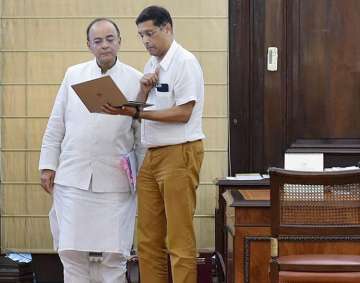Midnight function, former PMs and a gong: How govt plans to usher in the GST on June 30
The government plans to sound a gong at midnight to signify that the GST has arrived

The government has some elaborate plans to ring in the much-anticipated Goods and Services Tax, the biggest tax reform that the country has seen. There are hectic preparations underway at the Central Hall of Parliament where the government plans to hold a launch event at midnight June 30. The government’s midnight plans to usher in the sweeping tax reform has already drawn comparisons with the tryst with destiny on the midnight of August 15, 1947.
The government will use the circular-shaped Central Hall, perhaps for the first time, to launch a new taxation system that is set to dramatically re-shape the over $2 trillion economy.
Finance Minister Arun Jaitley today announced that GST will be launched from midnight of June 30-July 1 at a function to be held at Central Hall of Parliament. MPs, CMs and state finance ministers are among those invited, he said. President Pranab Mukherjee, Vice-President, PM, Lok Sabha Speaker and former PMs Manmohan Singh and HD Deve Gowda will be on the dais for GST launch, he added.
The launch event is scheduled start at 11 pm on June 30 and extend into a few minutes after midnight, coinciding with the rollout of the Goods and Services Tax (GST) regime.
The government also plans to sound a gong at midnight to signify that the GST has arrived.
The launch programme will see members of both Houses of Parliament in a joint sitting in the Central Hall of Parliament where the President, Prime Minister and the Finance Minister are likely to address. However, this will not be a joint session of Parliament but just a function to usher in the tax reform.
Conceptualised and originally piloted by President Mukherjee as the Finance minister in the previous UPA regime, the new tax code unifies more than a dozen separate levies to create a single market with a population greater than the US, Europe, Brazil, Mexico and Japan put together. GST will simplify a web of taxes, regulations and border levies by subsuming an array of central and state levies including excise duty, service tax and VAT.
Speaking of the reform, Jaitley said that the GST would eventually lead to greater revenues for states and the Centre, a development that would subsequently push the size of the economy as well.
"Over medium to long term, revenues of Centre, states will grow; size of formal economy will grow too," he said.
At the June 30 function, former Prime Minister Manmohan Singh would also occupy the high table along with another former PM HD Deve Gowda in the Central Hall. Chief ministers of all states will be invited for the event as GST represented an unprecedented exercise in fiscal federalism. GST council members will be the guests.
The GST council, that brings together the central and state governments, has met 17 times to thrash out how the tax will work.
Originally, the launch of GST, which has been in works for over a decade, was to be done from Vigyan Bhawan - the largest convention centre in the national capital that has hosted majority of the meetings of the GST Council.
Dubbed as the most significant economic reform since BJP government came to power in 2014, the GST is expected to add as much as 2 percentage points to the GDP growth rate besides raising government revenues by widening the tax net.
Speaking of the concerns related to the switchover in taxation systems, Jaitley agreed there could be some initial hiccups. "In short term, there will be some challenges in switchover to GST," Jaitley said. He however, added, that there was no excuse for people not being ready for it.
"We had been saying GST will be rolled out by July 1; nobody had any business not to be ready," he said.
A four-rate structure that exempts or imposes a low rate of tax of 5 per cent on essential items and top rate of 28 per cent on cars and consumer durables has been finalised. The other slabs of tax are 12 and 18 per cent.
(With agencies)